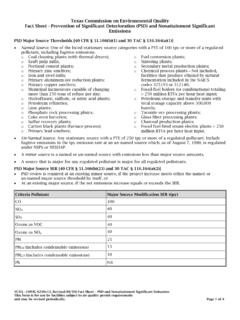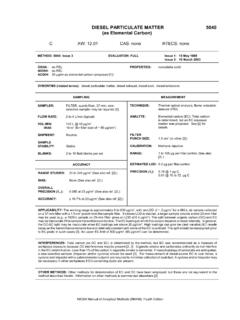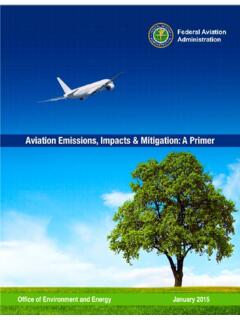Transcription of Section 6 Particulate Matter Controls
1 Section 6 Particulate Matter ControlsEPA/452/B-02-0012-1 Chapter 2 Wet Scrubbers for Particulate MatterDaniel MussattiInnovative Strategies and Economics GroupAir Quality Strategies and Standards DivisionOffice of Air Quality Planning and Environmental Protection AgencyResearch Triangle Park, NC 27711 Paula Pechan & Associates, Lyckan Parkway, Suite 2002 Durham, NC 27707 July, 15 2002 EPA/452 Process Capture Scrubber Types .. Spray Spray Tray Venturi Configuration and Operation of Venturi Storage and Delivery Injection Venturi Throat Chamber and Mist Waste Liquid Collection and Design Velocity and Pressure Size Distribution and Waste Gas Flow Rate, Temperature, and System PM Distribution and Waste Gas Pressure Scrubber Velocity and Cross-Sectional Power Cost Total Capital Equipment and Indirect Installation Annual Annual Example Matter (PM) is the general term used for a mixture of solid particles and liquiddroplets suspended in air.
2 EPA defines PM10 as particle Matter having a nominal aerodynamicdiameter of 10 micrometer ( m) or less. is defined as PM less than or equal to m inaerodynamic diameter. In general, coarse PM refers to PM10 while fine PM refers to wet scrubber is an air pollution control device that removes PM and acid gases fromwaste gas streams of stationary point sources. The pollutants are removed primarily through theimpaction, diffusion, interception and/or absorption of the pollutant onto droplets of liquid. Theliquid containing the pollutant is then collected for disposal. There are numerous types of wetscrubbers which remove both acid gas and PM. This chapter addresses the design and cost ofwet scrubbers for control of PM10 and (See Section Chapter 1 for information regardingwet scrubbers for acid gas control.)Collection efficiencies for wet scrubbers vary with the particle size distribution of the wastegas stream.
3 In general, collection efficiency decreases as the PM size decreases. Collectionefficiencies also vary with scrubber type. Collection efficiencies range from greater than 99% forventuri scrubbers to 40-60% (or lower) for simple spray towers [1]. Improvements in wet scrubberdesigns have increased collection efficiencies in the sub-micron range. Wet scrubber systems have some advantages over electrostatic precipitators (ESPs) andbaghouses. Wet scrubbers are smaller and more compact than baghouses or ESPs. They havelower capital cost and comparable operation and maintenance (O&M) costs. Wet scrubbers areparticularly useful in the removal of PM with the following characteristics: Sticky and/or hygroscopic materials (materials that readily absorb water); Combustible, corrosive and explosive materials; Particles which are difficult to remove in their dry form; PM in the presence of soluble gases; and PM in waste gas streams with high moisture scrubbers have numerous industrial applications including industrial boilers, incinerators,metals processing, chemical production, and asphalt production, and fertilizer primary disadvantage of wet scrubbers is that increased collection efficiency comes atthe cost of increased pressure drop across the control system [2].
4 Another disadvantage is thatthey are limited to lower waste gas flow rates and temperatures than ESPs or baghouses. Currentwet scrubber designs accommodate air flow rates over 47 actual cubic meters per second (m3/s)(100,000 actual cubic feet per minute (acfm)) and temperatures of up to 400 C (750 F). Anotherdisadvantage is that they generate waste in the form of a sludge which requires treatment and/or2-5disposal. Lastly, downstream corrosion or plume visibility problems can result unless the addedmoisture is removed from the gas DescriptionThis Section presents wet scrubber designs used for the control of PM10 and emittedfrom stationary point sources. Only commonly applied scrubber designs are MechanismsParticulates contact liquid droplets in wet scrubbers through several mechanisms. Impactionis the primary capture mechanism. When waste gas approaches a water droplet, it flows alongstreamlines around the droplet.
5 Particles with sufficient inertial force maintain their forward trajectoryand impact the droplet. Due to their mass, particles with diameters greater than 10 m are generallycollected using impaction [3]. Turbulent flow enhances capture by dominated by fluid drag forces follow the streamlines of the waste gas. However,particles that pass sufficiently close to a water droplet are captured by interception, capture due tothe surface tension of the water droplet. Particles of of roughly to m in diameter aresubject to interception [21]. Increasing the density of droplets in a spray increases interception[1].Very small-sized particles are subject to Brownian motion, irregular motion caused byrandom collisions with gas molecules. These particles are captured by the water droplet as theydiffuse through the waste gas. Collection due to diffusion is most significant for particles less m in diameter [1].Capture mechaisms that are used less frequently include condensation and condensation scrubbing, a gas stream is saturated with water vapor and the particle is capturedwhen the water condenses on the particle [3].
6 In electrostatic scrubbing, contact is enhanced byplacing an electrostatic charge on the particle, droplet, or both [2]. TowerThe simplest type of scrubber is the spray tower. In a spray tower, Particulate -laden airpasses into a chamber where it contacts a liquid spray produced by spray nozzles. Towers can beplaced in either vertical or horizontal waste gas flow paths. The liquid spray can be directedcounter to the gas flow, in the same direction as the gas flow, or perpendicular to the gas shows an example of a vertical countercurrent spray chamber. The gas flow enters atthe bottom of the tower and flows upward. Water sprays downward from nozzles mounted on the2-6walls of the tower or mounted on an array at the tower center. Water droplets capture particlessuspended in the gas flow through impaction, interception and diffusion. Droplets large enough tosettle by gravity collect at the bottom of the chamber.
7 Droplets that remain entrained in the gasstream are collected on a mist eliminator upstream of the nozzles [2]. ( Section discussesmist eliminators in more detail)Water SprayMistEliminatorClean Gas OutCleanScrubber LiquidDirty Scrubber Liquid OutDirty GasFigure : Spray Tower [4]Spray towers rely primarily on particle collection by impaction; therefore, they have highcollection efficiencies for coarse PM. Typical removal efficiencies for a spray tower can be asgreat as 90% for particles larger than 5 m. Removal efficiencies for particles from 3 to 5 m indiameter range from 60 to 80%. Below 3 m, removal efficiencies decline to less than 50%.Spray tower applications include control of PM emissions from grinding operations, pigment2-7operations, and dust control in fertilizer plants. Spray towers can also be applied to control PMfrom asphalt plant aggregate dryers [1].Spray towers have lower capital costs than other wet scrubbers.
8 Also, spray towersgenerally have lower power consumption and are not prone to fouling, so operating costs are alsolower [5]. Operating costs of spray towers increase for fine PM applications, because suchsystems require high liquid to gas ratios (over 20 gallons per 1000 cubic feet (gal/1000 ft3)).Typical gas flow rates for spray towers are 1 to 47 standard m3/s (1,500 to 100,000 standardcubic feet per minute (scfm)) [6]. Spray TowerCyclonic spray towers differ from spray tower designs in that the waste gas stream flowsthrough the chamber in a cyclonic motion. The cyclonic motion is produced by postitioning the gasinlet tangential to the wall of the scrubbing chamber or by placing turning vanes within the scrubbingchamber. The gas inlet is tapered so that the gas velocity increases as it enters the tower. Thescrubbing liquid is sprayed from nozzles in a central pipe (tangential inlet) or from the top of thetower (turning vanes) [1].
9 Figure shows a diagram of a cyclonic spray tower with a tangentialinlet [4]. Liquid droplets entrained in the gas stream experience a centrifugal force resulting fromthe rotating motion of the gas stream, causing them to migrate toward to the tower walls [2]. Thedroplets impact on the tower walls and fall to the bottom of the tower. Droplets that remainentrained in the waste gas can be removed with a mist spray towers have greater collection efficiencies than simple spray towers due tothe greater relative velocity between the droplets and the waste gas in a cyclonic tower. Collectionefficiencies for this type of scrubber are as high as 95% for particles greater than 5 m, and from60% to 75% for submicron particles. Typical applications are for dust control in fertilizer plants,grinding operations, and foundries [1]. Gas flow rates range from 1 to 47 m3/s (1,500 to 100,000scfm), and power input for a cyclonic scrubber is generally 1 to horsepower per 1000 cubicfeet per minute (hp/1000 cfm) [2, 6].
10 Capital costs and operation and maintenance costs areslightly higher for cycolonic spray towers due to their more complex ScrubberDynamic scrubbers are also known as mechanically-aided scrubbers or disintegratorscrubbers. This type of scrubber is similar to spray towers, but with the addition of a power-driven rotor that shears the scrubbing liquid into finely dispersed droplets. The rotor can belocated inside the tower or outside the tower, connected by a duct. A mist eliminator or cyclonicseparator removes the liquid and captured PM. Most dynamic scrubber systems humidify thewaste gas upstream of the rotor to reduce evaporation and particle deposition in the rotar area [1].2-8 Dirty GasDirty LiquidClean LiquidClean GasFigure : Cyclonic Spray Scrubber [3]Dynamic scrubbers efficiently remove fine PM, but the addition of a rotar to the scrubbersystem increases the maintence costs. Large PM abrades the rotars and the humid gas streamcorrodes them.













